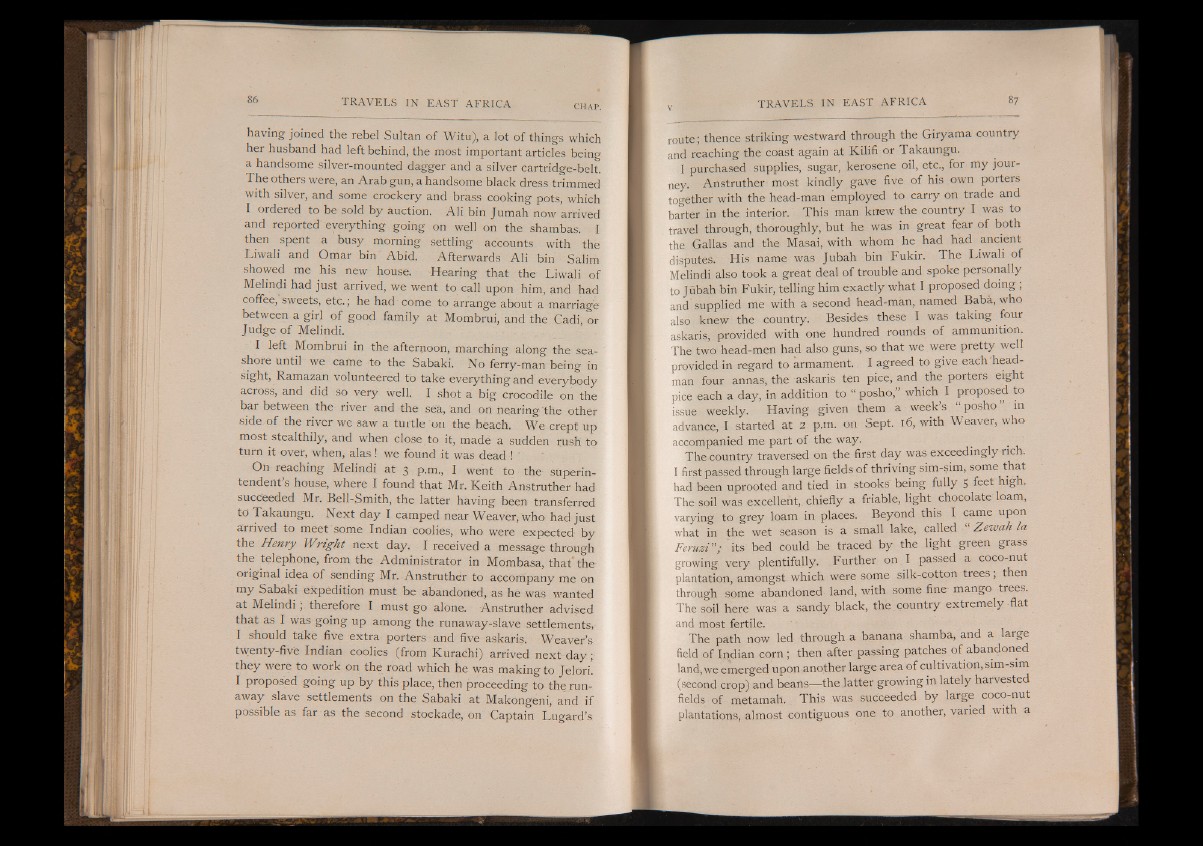
having joined the rebel Sultan of Witu), a lot of things which
her husband had left behind, the most important articles being
a handsome silver-mounted dagger and a silver cartridge-belt.
The others were, an Arab gun, a handsome black dress trimmed
with silver, and some crockery and brass cooking pots, which
I ordered to be sold by auction. Ali bin Jumah now arrived
and reported everything going on well on the shambas. I
then spent a busy morning settling accounts with the
Liwali and Omar bin Abid. Afterwards Ali bin Salim
showed me his new house. Hearing that the Liwali of
Melindi had just arrived, we went to call upon him, and had
coffee, sweets, etc.; he had come to arrange about a marriage
between a girl of good family at Mombrui, and the Cadi, or
Judge of Melindi.
I left Mombrui in the afternoon, marching along the seashore
until we came to the Sabaki. No ferry-man being in
sight, Ramazan volunteered to take everything and everybody
across, and did so very well. I shot a big crocodile on the
bar between the river and the sea, and on nearing the other
side of the river we saw a turtle on the beach. We crept up
most stealthily, and when close to it, made a sudden rush to
turn it over, when, alas I we found it was dead ! '
On reaching Melindi at 3 p.m., I went to the superintendent
s house, where I found that Mr. Keith Anstruther had
succeeded Mr. Bell-Smith, the latter having been transferred
to Takaungu. Next day I camped near Weaver, who had just
arrived to meet some Indian coolies, who were expected by
the Henry Wright next day. I received a message through
the telephone, from the Administrator in Mombasa, that" the
original idea of sending Mr. Anstruther to accompany me on
my Sabaki expedition must be abandoned, as he was wanted
at Melindi | therefore I must go alone. Anstruther advised
that as I was going up among the runaway-slave settlements,
I should take five extra porters and five askaris. Weaver’s
twenty-five Indian coolies (from Kurachi) arrived next d a y ;
they were to work on the road which he was making to Jelori!
I proposed going up by this place, then proceeding to the runaway
slave settlements on the Sabaki at Makongeni, and if
possible as far as the second stoekade, on Captain Lugard’s
route; thence striking westward through the Giryama country
and reaching the coast again at Kilifi or Takaungu.
I purchased supplies, sugar, kerosene oil, etc., for my journey.
Anstruther most kindly gave five of his own porters
together with the head-man employed to carry on trade and
barter in the interior. This man knew the country I was to
travel through, thoroughly, but he was in great fear of both
the Gallas and the Masai, with whom he had had ancient
disputes. His name was Jubah bin Fukir. The Liwali of
Melindi also took a great deal of trouble and spoke personally
to Jubah bin Fukir, telling him exactly what I proposed doing ;
and supplied me with a second head-man, named Babà, who
also knew the country. Besides these I was taking four
askaris, provided with one hundred rounds of ammunition.
The two head-men had also guns, so that we were pretty well
provided in regard to armament. I agreed to give each headman
four annas, the askaris ten pice, and the porters eight
pice each a day, in addition to “ posho,” which I proposed to
issue weekly. Having given them a week’s “ posho” in
advance, I started at 2 p.m. on Sept. 16, with Weaver, who
accompanied me part of the way.
The country traversed on the first day was exceedingly rich.
I first passed through large fields of thriving sim-sim, some that
had been uprooted and tied in stooks being fully 5 feet high,
The soil was excellent,, chiefly a friable, light chocolate loam,
varying to grey loam in places. Beyond this I came upon
what in the wet season is a small lake, called “ Zewah la
Feruzi "; its bed could be traced by the light green grass
growing very plentifully. Further on I passed a coco-nut
plantation, amongst which were some silk-cotton trees ; then
through some abandoned land, with some fine- mango trees.
The soil here was a sandy black, the country extremely flat
and most fertile.
The path now led through a banana shamba, and a large
field of Indian corn ; then after passing patches of abandoned
land, we emerged upon another large area of cultivation, sim-sim
(second crop) and beans— the latter growing in latély harvested
fields of metamah. This was succeeded by large coco-nut
plantations, almost contiguous one to another, varied with a